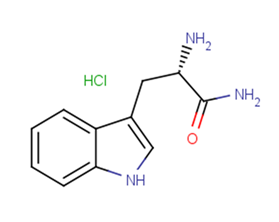
L-Tryptophanamide hydrochloride
CAS No. 5022-65-1
L-Tryptophanamide hydrochloride( (2S)-2-amino-3-(1H-indol-3-yl)propanamide hydrochloride )
Catalog No. M19733 CAS No. 5022-65-1
Tryptophanamide belongs to the class of organic compounds known as tryptamines and derivatives. Tryptophanamide has been detected in multiple biofluids such as urine and blood.
Purity : >98% (HPLC)
 COA
COA
 Datasheet
Datasheet
 HNMR
HNMR
 HPLC
HPLC
 MSDS
MSDS
 Handing Instructions
Handing Instructions
| Size | Price / USD | Stock | Quantity |
| 100MG | 38 | In Stock |


|
| 200MG | Get Quote | In Stock |


|
| 500MG | Get Quote | In Stock |


|
| 1G | Get Quote | In Stock |


|
Biological Information
-
Product NameL-Tryptophanamide hydrochloride
-
NoteResearch use only, not for human use.
-
Brief DescriptionTryptophanamide belongs to the class of organic compounds known as tryptamines and derivatives. Tryptophanamide has been detected in multiple biofluids such as urine and blood.
-
DescriptionTryptophanamide belongs to the class of organic compounds known as tryptamines and derivatives. Tryptophanamide has been detected in multiple biofluids such as urine and blood.
-
In Vitro——
-
In Vivo——
-
Synonyms(2S)-2-amino-3-(1H-indol-3-yl)propanamide hydrochloride
-
PathwayOthers
-
TargetOther Targets
-
RecptorOthers
-
Research Area——
-
Indication——
Chemical Information
-
CAS Number5022-65-1
-
Formula Weight239.7
-
Molecular FormulaC11H14ClN3O
-
Purity>98% (HPLC)
-
SolubilityDMSO:200 mM
-
SMILESCl.N[C@@H](Cc1c[nH]c2ccccc12)C(N)=O
-
Chemical Name——
Shipping & Storage Information
-
Storage(-20℃)
-
ShippingWith Ice Pack
-
Stability≥ 2 years
Reference
molnova catalog



related products
-
A2793
A2793 is a chemical compound.
-
HCV Nucleoprotein (8...
HCV Nucleoprotein (88-96)
-
(3S)-(-)-3-(DIMETHYL...
(3S)-(-)-3-(DIMETHYLAMINO)PYRROLIDINE



 Cart
Cart
 sales@molnova.com
sales@molnova.com


